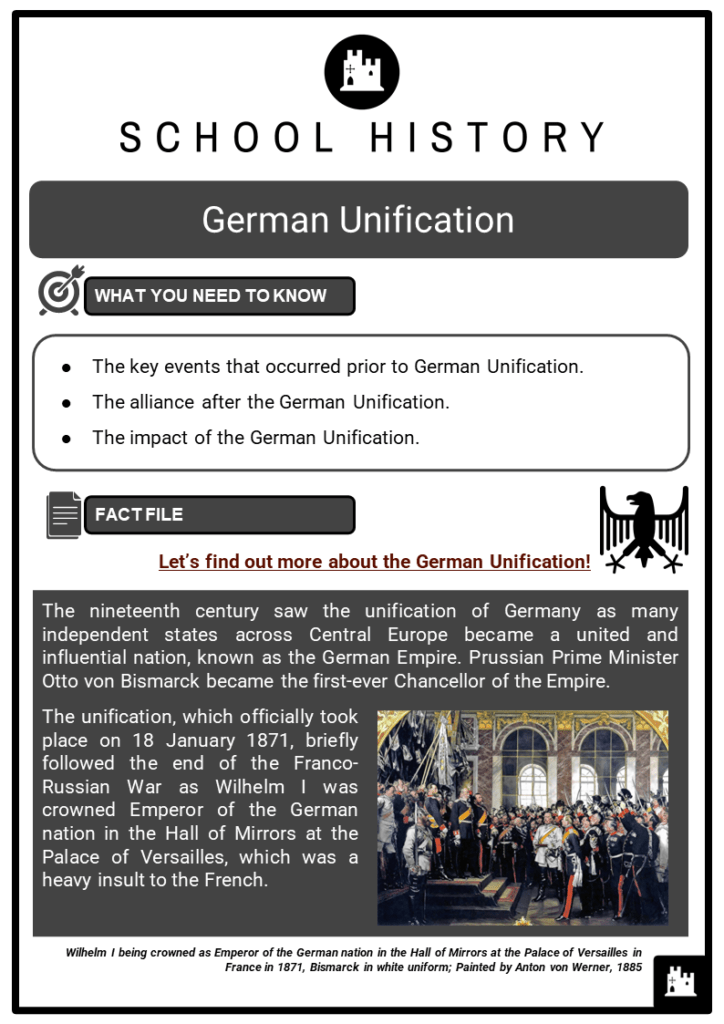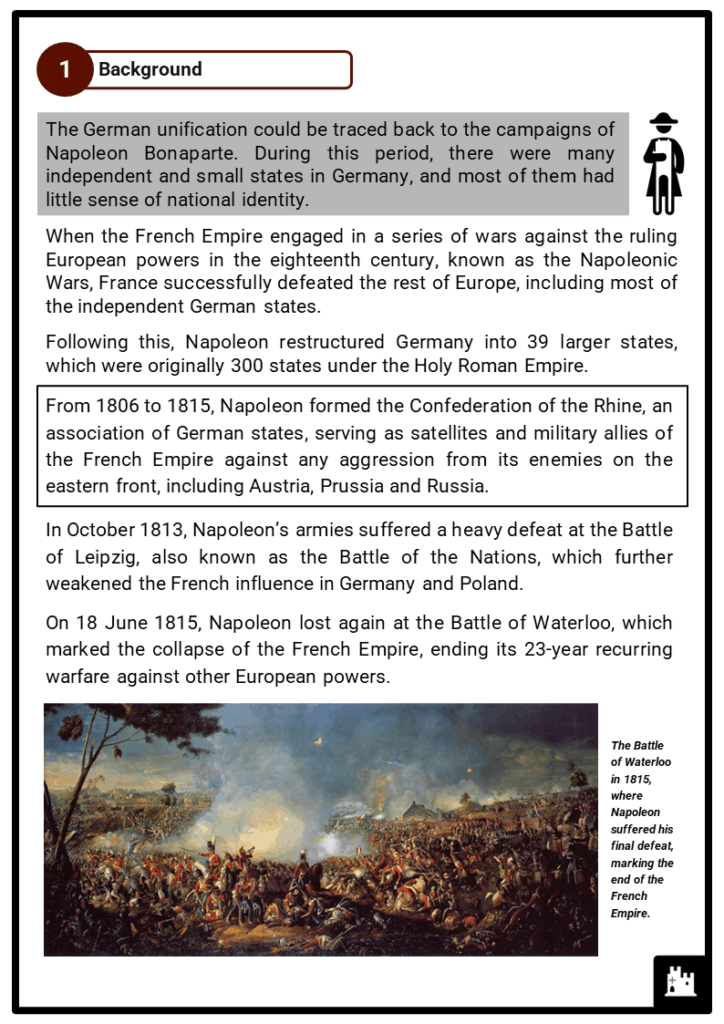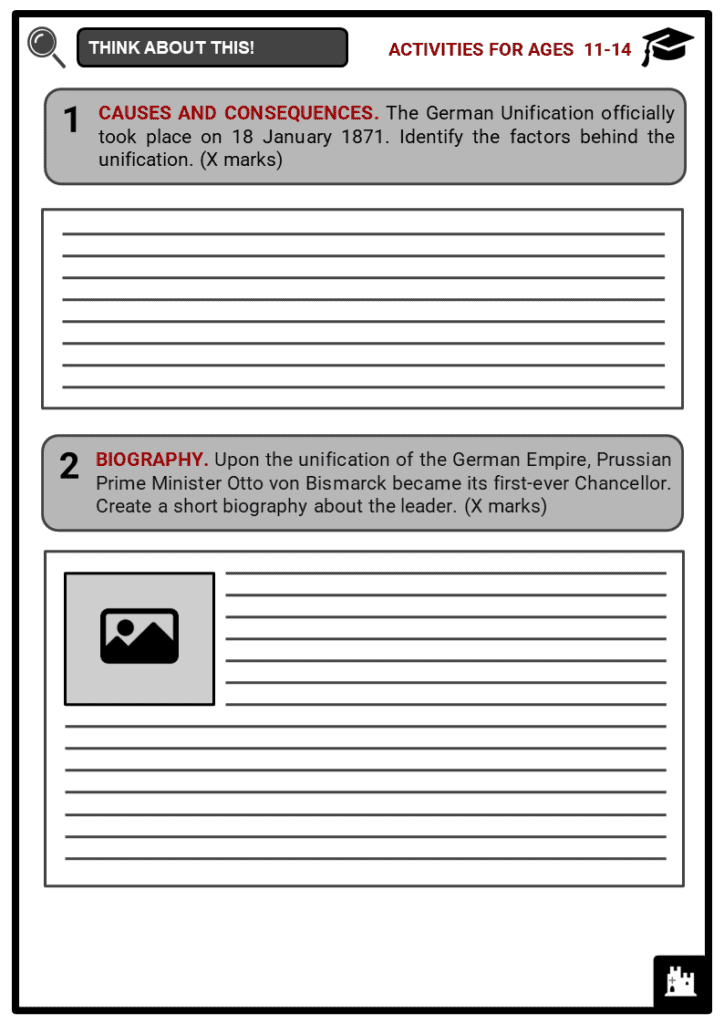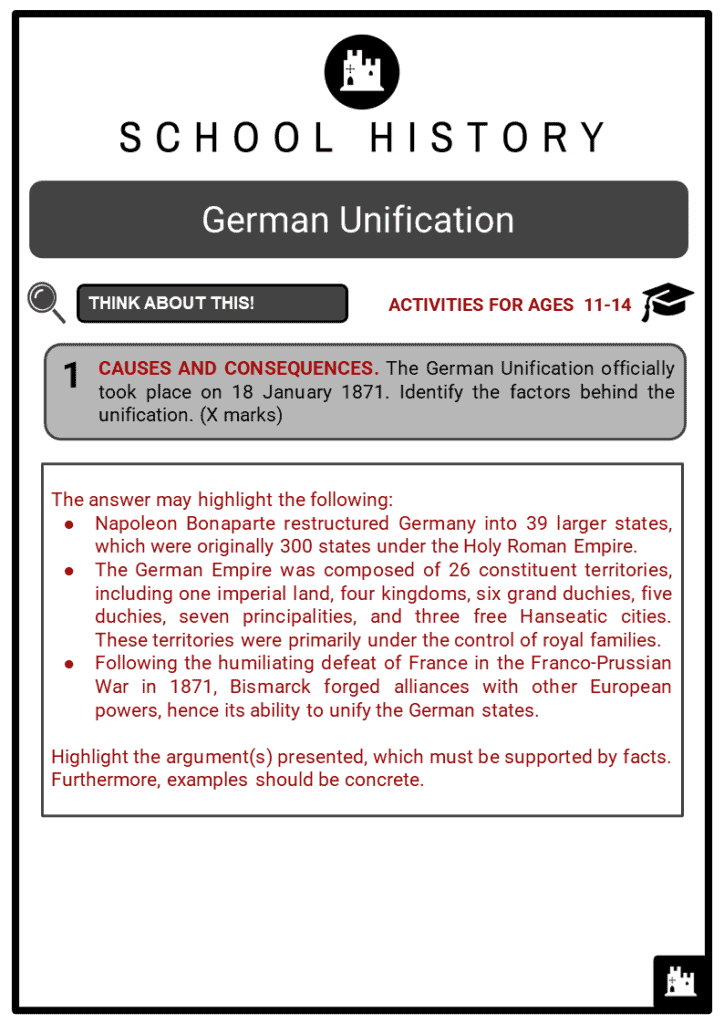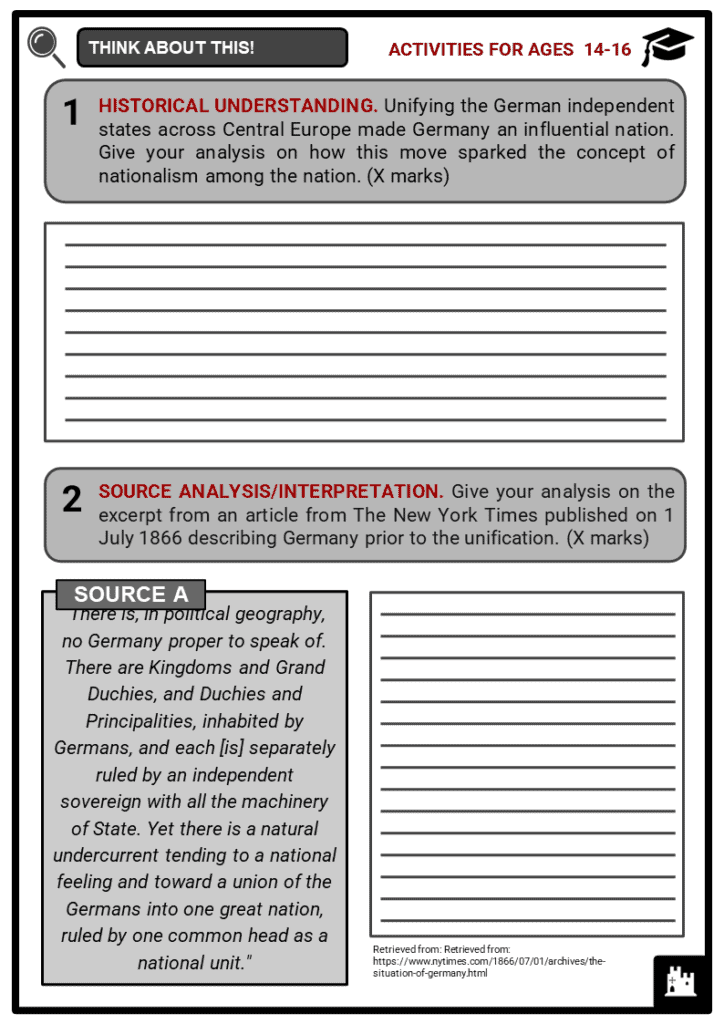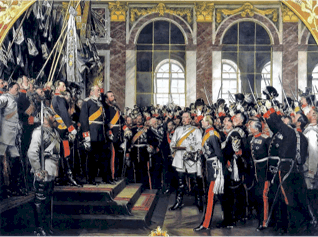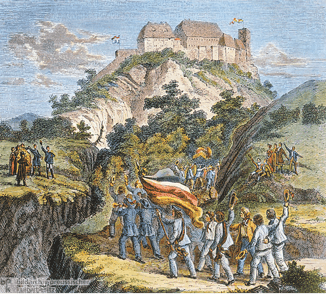Download German Unification Worksheets
Do you want to save dozens of hours in time? Get your evenings and weekends back? Be able to teach German Unification to your students?
Our worksheet bundle includes a fact file and printable worksheets and student activities. Perfect for both the classroom and homeschooling!
Table of Contents
Add a header to begin generating the table of contents
Summary
- The key events that occurred prior to German Unification.
- The alliance after the German Unification.
- The impact of the German Unification.
Key Facts And Information
Let’s find out more about the German Unification!
- The nineteenth century saw the unification of Germany as many independent states across Central Europe became a united and influential nation, known as the German Empire. Prussian Prime Minister Otto von Bismarck became the first-ever Chancellor of the Empire.
- The unification, which officially took place on 18 January 1871, briefly followed the end of the Franco-Russian War as Wilhelm I was crowned Emperor of the German nation in the Hall of Mirrors at the Palace of Versailles, which was a heavy insult to the French.
Background
- The German unification could be traced back to the campaigns of Napoleon Bonaparte. During this period, there were many independent and small states in Germany, and most of them had little sense of national identity.
- When the French Empire engaged in a series of wars against the ruling European powers in the eighteenth century, known as the Napoleonic Wars, France successfully defeated the rest of Europe, including most of the independent German states.
- Following this, Napoleon restructured Germany into 39 larger states, which were originally 300 states under the Holy Roman Empire.
- From 1806 to 1815, Napoleon formed the Confederation of the Rhine, an association of German states, serving as satellites and military allies of the French Empire against any aggression from its enemies on the eastern front, including Austria, Prussia and Russia.
- In October 1813, Napoleon’s armies suffered a heavy defeat at the Battle of Leipzig, also known as the Battle of the Nations, which further weakened the French influence in Germany and Poland.
- On 18 June 1815, Napoleon lost again at the Battle of Waterloo, which marked the collapse of the French Empire, ending its 23-year recurring warfare against other European powers.
- Following the end of the Napoleonic Wars, the Allied forces dissolved the Confederation of the Rhine at the Congress of Vienna in 1815, thus putting an end to French occupation.
- Consequently, they established the Bund, also known as the German Confederation. The league was created to protect its member-states and foster cooperation from the ruling powers in Central Europe.
- However, the Confederation was divided by the rivalry of its most influential member-states, Austria and Prussia. It was also weakened by the Revolutions of 1848, led by liberals and nationalists.
- Even though the Confederation was reestablished in 1850, it eventually collapsed following the victory of Prussia in the 1866 Seven Weeks’ War. It was then replaced by the North German Confederation under Prussian leadership a year after. German states south of the region likewise became members of the new confederation, which was later named the German Empire.
The Unification
- The unification of Germany as one nation-state formally began on 18 January 1871 when Wilhelm I was hailed as the German Emperor in the Hall of Mirrors at the Palace of Versailles. This occurred after Prussia defeated France in the Franco-Prussian War, resulting in the occupation of the French provinces of Alsace and Lorraine.
- The German Empire was composed of 26 constituent territories, including one imperial land, four kingdoms, six grand duchies, five duchies, seven principalities, and three free Hanseatic cities. These territories were primarily under the control of royal families.
- Prussian leader Otto von Bismarck, who was hailed as the first-ever Chancellor of the German Empire, became a major part of maintaining Germany’s power and influence across Europe until 1890.
- Concerned by the possible retaliation of France following its humiliating defeat in the Franco-Prussian War in 1871, Bismarck forged alliances with other European powers, particularly Russia and Austria-Hungary.
- In 1872, the three ruling powers in Europe signed the League of Three Emperors, strengthening their alliance and establishing cooperation in terms of foreign policies.
- During this period, Germany was likewise becoming the leading industrial power across the world.
- To encourage the German people to remain loyal to the empire, Bismarck launched his revolutionary conservatism campaign, essentially granting social rights and establishing strong relations with the working class to counter threats of liberalism and socialism.
- In the 1880s, Bismarck formed the first-ever modern welfare state within Europe, thus creating national healthcare in 1883, accident insurance in 1884, and old-age pensions in 1889. He also passed universal male suffrage in 1871.
- Additionally, Bismarck initiated the Kulturkampf, a cultural struggle against Catholics at the time. Here, Bismarck removed Jesuits and put state control over parochial institutions.
- Bismarck’s influence ended on 18 March 1890 following his resignation as chancellor due to a conflict with Wilhelm II, the new emperor who succeeded Frederick III, the son of Wilhelm I.
Other Factors for Unification
- The industrialisation of Germany in the early nineteenth century also contributed to the eventual unification of its several independent states. Due to the Industrial Revolution, urbanisation and population increased.
- On the contrary, trade barriers, as well as disparities in laws and currencies, still impeded the economic expansion of most German states at the time. The majority of trade took place within and between the 39 states. Tariff restrictions, however, slowed the process.
- For these reasons, the German people believed the unification of Germany would pave the way to eradicate numerous taxes and tariffs and increase economic growth, given that production and transportation vastly improved.
- Prussia led this campaign for economic change in 1818 after abolishing trade barriers inside its own borders and lowering import rates. Other German states participated in this customs union during the 1820s and early 1830s. This eventually became known as the Zollverein.
- By 1836, 25 of Germany's 39 states had signed up to this economic alliance. This suggested that a more lasting political unity would be advantageous to them.
- In a similar manner, the rise of liberal and nationalist ideas in Europe, as introduced by the French, also helped the realisation of a unified Germany. When the Austrian power started to weaken in Prussia, liberalism and nationalism flourished.
- As Klemens von Metternich, the Austrian state chancellor, declared that liberalism was a threat to aristocracy, the German people, particularly the middle and the working class, became more engaged in political actions.
- During the French colonial rule, Burschenschaften, a nationalistic student society, developed within the German states. They campaigned for the overthrow of the old regime.
- As a form of retaliation against the growing movement, the German Confederation gathered at Carlsbad in 1819, where Metternich proposed the Carlsbad Decrees, a series of reactionary regulations to counter nationalist ideas. However, this would only lead to the German people’s campaign for nationalism and unification.
Image sources:
- https://upload.wikimedia.org/wikipedia/commons/7/72/A_v_Werner_-_Kaiserproklamation_am_18_Januar_1871_%283._Fassung_1885%29.jpg
- https://commons.wikimedia.org/wiki/File:Battle_of_Waterloo_1815.PNG
- https://upload.wikimedia.org/wikipedia/commons/8/8f/Wartburg_demonstration_1817.jpg

